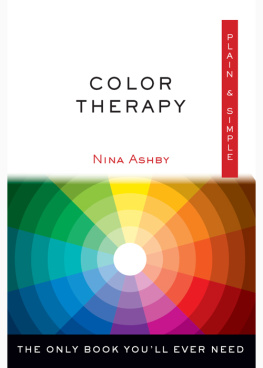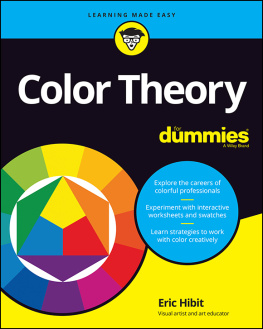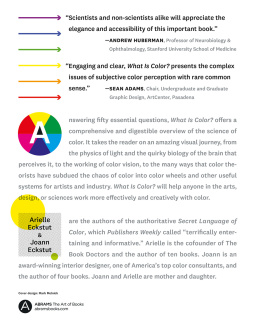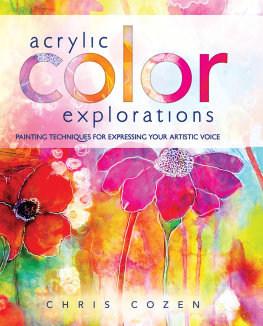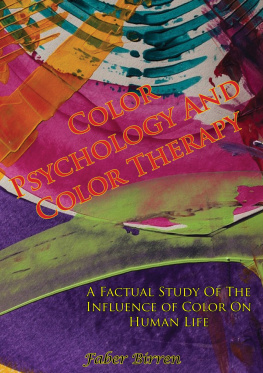

Copyright 2006, 2018
by Nina Ashby
All rights reserved. No part of this publication may be reproduced or transmitted in any form or by any means, electronic or mechanical, including photocopying, recording, or by any information storage and retrieval system, without permission in writing from Hampton Roads Publishing Company, Inc. Reviewers may quote brief passages. Previously published in 2006 as Simply Color Therapy by Sterling Publishing Co, NY and Zambezi Publishing Limited, Devon, UK.
Cover design by Jim Warner
Interior design by Kathryn Sky-Peck
Hampton Roads Publishing Company, Inc.
Charlottesville, VA 22906
Distributed by Red Wheel/Weiser, LLC
www.redwheelweiser.com
Sign up for our newsletter and special offers by going to
www.redwheelweiser.com/newsletter/
ISBN: 978-1-57174-787-7
Library of Congress Cataloging-in-Publication Data available upon request
Printed in the United States of America
IBI
10 9 8 7 6 5 4 3 2 1
Contents

INTRODUCTION
Our Experience of Color
W hat we experience as color is the interaction between light and darkness. In spiritual terms, Light was the first act of Creation and the beginning of separation between the things that might be possible and those that were made real. We are born into the light of the world and we die and are gathered into the Light of Spirit.
For most people, color is a continuing experience, and this is true even for those who are born blind or who have lost their sight. From the time we wake to the time we go to sleep, color is all around usin nature, in the buildings in which we work and live, and in the clothes we wear. When we close our eyes and see inner images, like all other types of energy, the energy of the colors we see has an effect upon us.
We are beings of light. Portions of our own subtle energy field (or aura) store information as color, which can be perceived clairvoyantly as fields of color that fluctuate with changes in our physical, mental, emotional, and spiritual states. Color has always been important in spiritual, psychic, and esoteric work because of the ways it can affect us.
You know more about color than you believe you do. Your unconscious mind already knows about color and selects the colors that express something about you and your inner state. For example, how many times have you taken a shirt out of your drawer, put it on, and thought, Wrong color for today! and then replaced it with a shirt of another color?
You might not have been able to analyze why that was, but you instinctively knew that the replacement color was right because it felt better.
By applying your knowledge of the effects of color to every aspect of your life, you can empower yourself to:
- Choose the colors you wear for all occasions and know what they say about you
- Know what colors to use to decorate your environment for a particular effect
- Understand others through the colors they choose to wear
- Improve your health through application of colored light, through awareness of color and nutrition in foods, and by doing color meditations
- Get more in touch with the subtle side of life and your spirituality
- Appreciate the full spectrum that life has to offer

The Color Spectrum
T he symbolism and application of colors are vast. I have therefore addressed each color individually and given an overview of its physical, emotional, and mental characteristics and meanings, as well as described its application in diet, decor, and fashion.
Describing a color is difficult because we all perceive colors slightly differently. I have had more disagreements with people about what color I am wearing than I can count! It is therefore useful to describe colors in reference to the living world, for example, sunflower yellow, forget-me-not blue, sky blue, pumpkin orange, fire-engine red, and so on.
I hope that this will set your mind working and inspire you to acknowledge how much you already understand about the nature of each color. This will give you some insight into color as well as give you a summary to refer to in the future.
Color Basics
Colors are neither good nor bad. Each color has particular properties relating to physical, emotional, mental, and spiritual states of being. Colors can be stimulating or depressing, constructive or destructive, attractive or repellent. They affect us more profoundly than we realize, a factor that becomes evident in the language we use to describe sensations, emotions, and situations.
Color contains information. For instance, the color series red-yellow-green is now so deeply embedded in our culture that its use is always read as stop-wait-go. Maps display color schemes to make them easy to read and understand. Color is used to draw attention to important information. It helps us to differentiate and remember data or facts, such as in the use of color coding on wiring or pipes in industry, and it helps us to define identity, such as in flags and uniforms.
Guidelines for Understanding the Meanings of Color
There are hot colorsred, yellow, and orange. There are cool colorsblue, green, and violet. Bright or highly contrasting colors draw the eye more quickly and are easier to see than pastel or low-contrast colors. They also define moods.
Colors indicate energy states that are either active and outgoing or receptive and inward turning. For example, both primary and secondary colors that are bright are perceived as being outgoing and active, as in fire-engine red or sunflower yellow. We all choose and use colors that are right for their purposes. Imagine having a candy-striped courtroom!
Use the following guidelines:
- In a combined color, we perceive the more dominant color as more influential. For example, in red-orange, red is the dominant color.
- Whenever white or black is added to a bright color, it progressively dilutes that color until it is completely absorbed by the black or white, and it changes the color's meaning accordingly.
- When white is added to a bright color, the psychological impact of that color becomes more innocent, ethereal, or insipid.
- When black is added to a bright color, the psychological impact of that color becomes more earthy, heavy, and repressed.
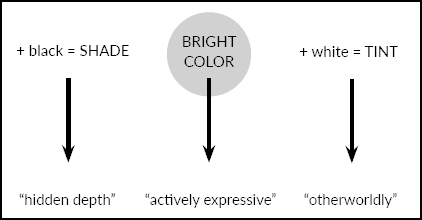
For Example: Red
Bright color: Fire-engine red
Meaning: Extroversion, energy, sportiness, attention-seeking behavior, aggressiveness
Shade: Red + Black = Moroccan red
Meaning: Conservativeness, masculinity, sexiness, suppressed physical energy
Tint: Red + (a little) White = Hot pink
Meaning: Naughty innocence, teenage quality, assertiveness, energetic fun
Tint: Red + (a lot of) White = Baby pink
Meaning: Physical innocence, sweetness, softness, vulnerability
Next page
